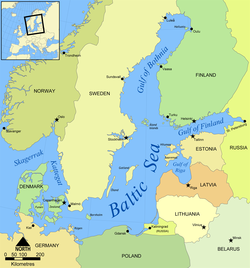(Redirected from Northeastern Europe)
Jump to navigationJump to search
Baltic Sea and surrounding countries
The terms Baltic Sea Region, Baltic Rim countries (or simply Baltic Rim), and the Baltic Sea countries/states refer to slightly different combinations of countries in the general area surrounding the Baltic Sea in Northern Europe.
Etymology[edit]
The first to name it the Baltic Sea (Latin: Mare Balticum) was 11th century German chronicler Adam of Bremen.
Denotation[edit]

Lennart Meri, the President of Estonia, reconstructs the history of Estonia and the Baltic Sea region in his 1976 book Silver White (Estonian: Hõbevalge).[1]
Depending on the context the Baltic Sea Region might stand for:
- The countries that have shorelines along the Baltic Sea: Denmark, Estonia, Latvia, Finland, Germany, Lithuania, Poland, Russia, and Sweden.
- The group of countries presently referred to by the shorthand Baltic states: Estonia, Latvia, and Lithuania.[citation needed]
- Estonia, Latvia, Lithuania and Kaliningrad Oblast of Russia, exclaved from the remainder of Russia. [2]
- Historic East Prussia and the historical lands of Livonia, Courland and Estonia (Swedish Estonia and Russian Estonia).[citation needed]
- The former Baltic governorates of Imperial Russia: Today's Estonia and Latvia (excluding parts of modern Eastern Latvia that were part of Vitebsk Governorate).[citation needed]
- The countries on the historical British trade route through the Baltic Sea, i.e. including the Scandinavian Peninsula (Sweden and Norway).[citation needed]
- The Council of the Baltic Sea States, comprised by the countries with shorelines along the Baltic Sea, in addition to Norway, Iceland and the rest of European Union.[citation needed]
- The islands of the Euroregion B7 Baltic Islands Network, which includes the islands and archipelagos Åland (autonomous), Bornholm (Denmark), Gotland (Sweden), Hiiumaa (Estonia), Öland (Sweden), Rügen (Germany), and Saaremaa (Estonia).[citation needed]
- On historic Scandinavian and German maps, the Balticum sometimes includes only the historically or culturally German-dominated lands, or provinces, of Estonia, Livonia, Courland and Latgale (corresponding to modern Estonia and Latvia), as well as sometimes Pomerania, Kashubia and East Prussia, while the historically less-Germanized Lithuania is occasionally excluded.[citation needed]
- In geology, the Baltic Shield includes Fennoscandia, parts of northwestern Russia and the northern Baltic Sea.[citation needed]
See also[edit]
- Baltia (Roman mythology)
- Baltic states
- Baltoscandia
- Council of the Baltic Sea States
- List of Intangible Cultural Heritage elements in Northern Europe
- Nordic Estonia
- Northern Dimension
- North Sea Region
References[edit]
- ^ Postimees: "Medical scientist proves hypothesis set by Lennart Meri".
- ^ «The Baltic region includes the Baltic republics and the Kaliningrad region of the RSFSR "» — Baltic region in the Great Soviet Encyclopedia, 1969–1978 (in Russian)
Further reading[edit]
- Norbert Götz. "Spatial Politics and Fuzzy Regionalism: The Case of the Baltic Sea Area." Baltic Worlds 9 (2016) 3: 54–67.
External links[edit]
| Wikimedia Commons has media related to Baltic region. |
- Council of the Baltic Sea States official website
- The Baltic Sea Information Centre
- EU Baltic Sea Region Strategy (EUSBSR) - a strategy aiming to accelerate the integration of the region
- The Baltic University Programme - a University network focused on a sustainable development in the Baltic Sea region.
- Baltic Sea Region Spatial Planning Initiative VASAB
- Baltic Sea Region Programme 2007-2013
- Vifanord – a digital library that provides scientific information on the Nordic and Baltic countries as well as the Baltic region as a whole.